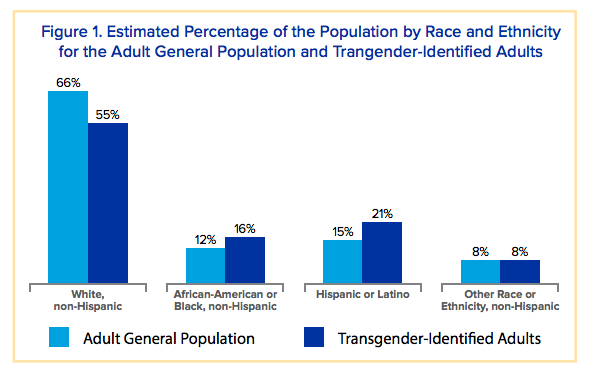feature image via Shutterstock
Trans people are more racially and ethnically diverse than the U.S. general population, finds a new study by The Williams Institute at the UCLA School of Law.
In “Race and Ethnicity of Adults who Identify as Transgender in the United States,” the researchers used data from the CDC’s Behavioral Risk Factor Surveillance System (BRFSS), a state-level, population-based survey to compile their study. They found trans people are less likely to be white and more likely to be Latinx or Black than the general U.S. population. Among the survey-takers who identified as transgender, 55 percent identify as white, 16 percent identify as African-American or black, 21 percent identify as Latino or Hispanic, and 8 percent identify as another race or ethnicity. Here’s how that looks like compared to the U.S. general population:

At least one prior study, with smaller sample sizes, has had similar results, showing trans individuals as more racially and ethnically diverse than the US as a whole — it “found that in Massachusetts adults who identify as transgender are significantly less likely to identify as White and more likely to identify as Latino or Hispanic than the non-transgender adult population.” But the Williams Institute study is the first to give an estimate of the racial makeup of trans adults in all 50 states and the District of Columbia. (In contrast, the racial makeup of the sample size for Injustice At Every Turn, the report on the national transgender discrimination survey, was 83% white.)
The study also finds that the racial demographic patterns of where trans adults live are similar to the broader racial demographic patterns found throughout the United States. For example, the highest percentage of trans Latinx people are found in the Southwest, just like there’s a larger percentage of Latinxs who live there in general.

“While our study confirms that people who identify as transgender are racially and ethnically diverse, the question remains as to why transgender people are more diverse than others,” Taylor N.T. Brown, a Public Policy Analyst at the Williams Institute, said in a press release. “We need more research before we can answer that question.”

For years I’ve had a problem with the limited race/ethnicity options, because it’s not accurate enough. White, non-Hispanic is too generic. I guess that kind of works, but for years since middle school I was told to choose white, and that other means non-North American indigenous people. I even had an English teacher correct my ethnicity on a standardized test, because I chose other. I’m of Iranian decent(Mizrahi tribe of Jews to be exact), but my teacher told me I’m white(I’m technically Caucasian due to location to the Caucus mountains, but I prefer middle east as a choice). If there was a Middle Eastern option(yes technically a couple of different ethnicity) it would the preferred choice for me. It would be cool to know an estimate on how many other Middle Eastern and/or Jewish trans people are in the US. I actually kind of expect better form UCLA as the campus is down the street from Little Tehran.
They’re using federally collected data it looks like, so they don’t get to pick the race/ethnicity categories and instead must use the ones available to them in the existing data or mandated by the funding body, so it seems like the researchers themselves don’t have much choice in the categorization. It would be nice if the government (CDC) got on board though!
Oh, well that’s not good. It would be nice if they could get add less generic categories in order to get more accurate data.
That’s seems strange, maybe economic factors meaning white people are more likely to be stealth or not transition? Wonder how it varies with age?
Kinda confirms that the Binary gender system is a White invented/enforced institution.
My first reaction was that there could be something up with the sample / collection method (white trans people were less likely to take the survey for some reason), but if that was not the case it would be more interesting. Could be that white gender nonconforming people don’t identify with the trans label for some reason, perhaps because the concept of multiple gender identities is more common or familiar in non white cultures or because the concept of transition is more familiar.
I think they find similar things for queer people more generally, meaning more PoC than white people have same gender attraction. To me that indicates it’s not the research methods necessarily but perhaps something else.